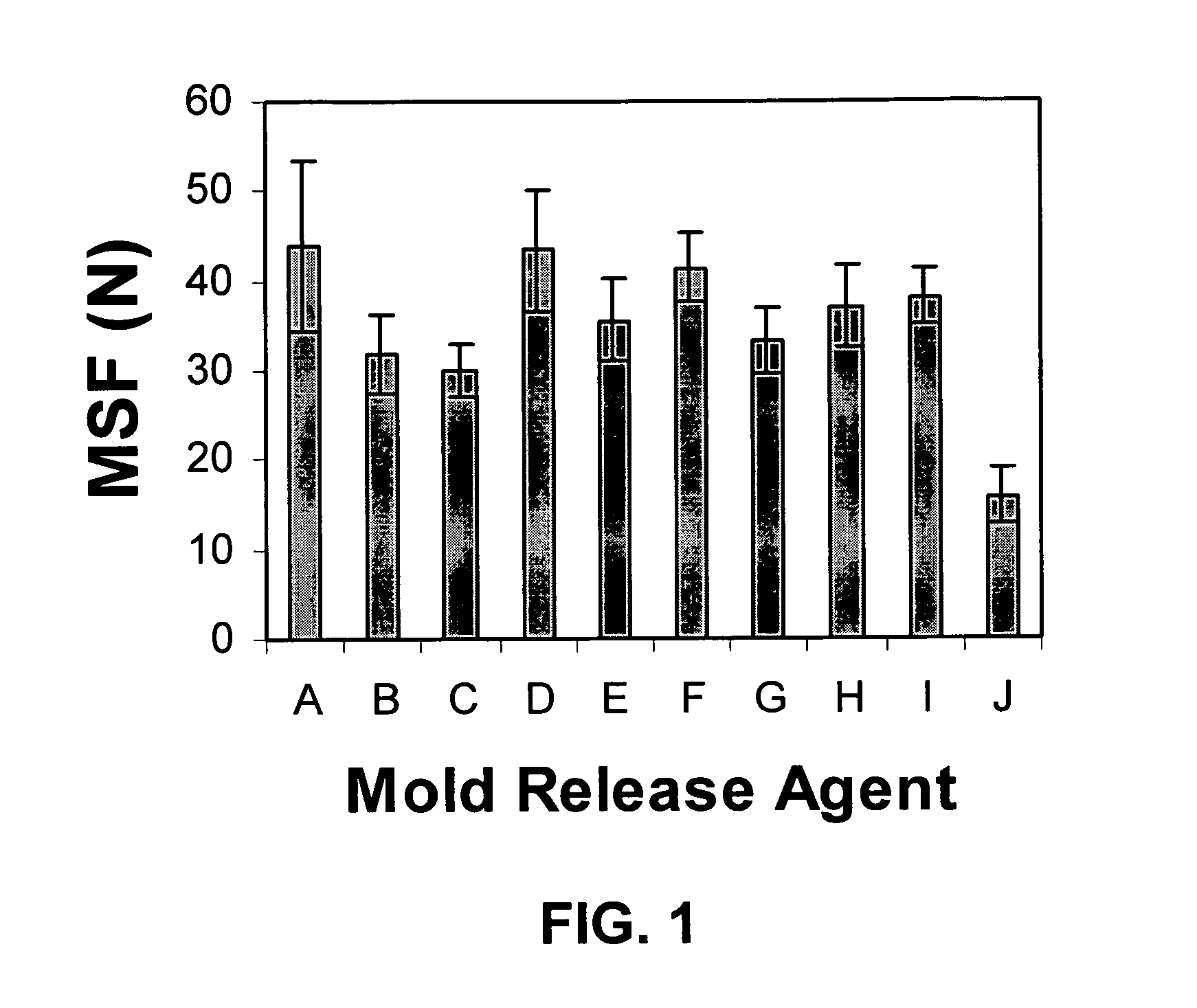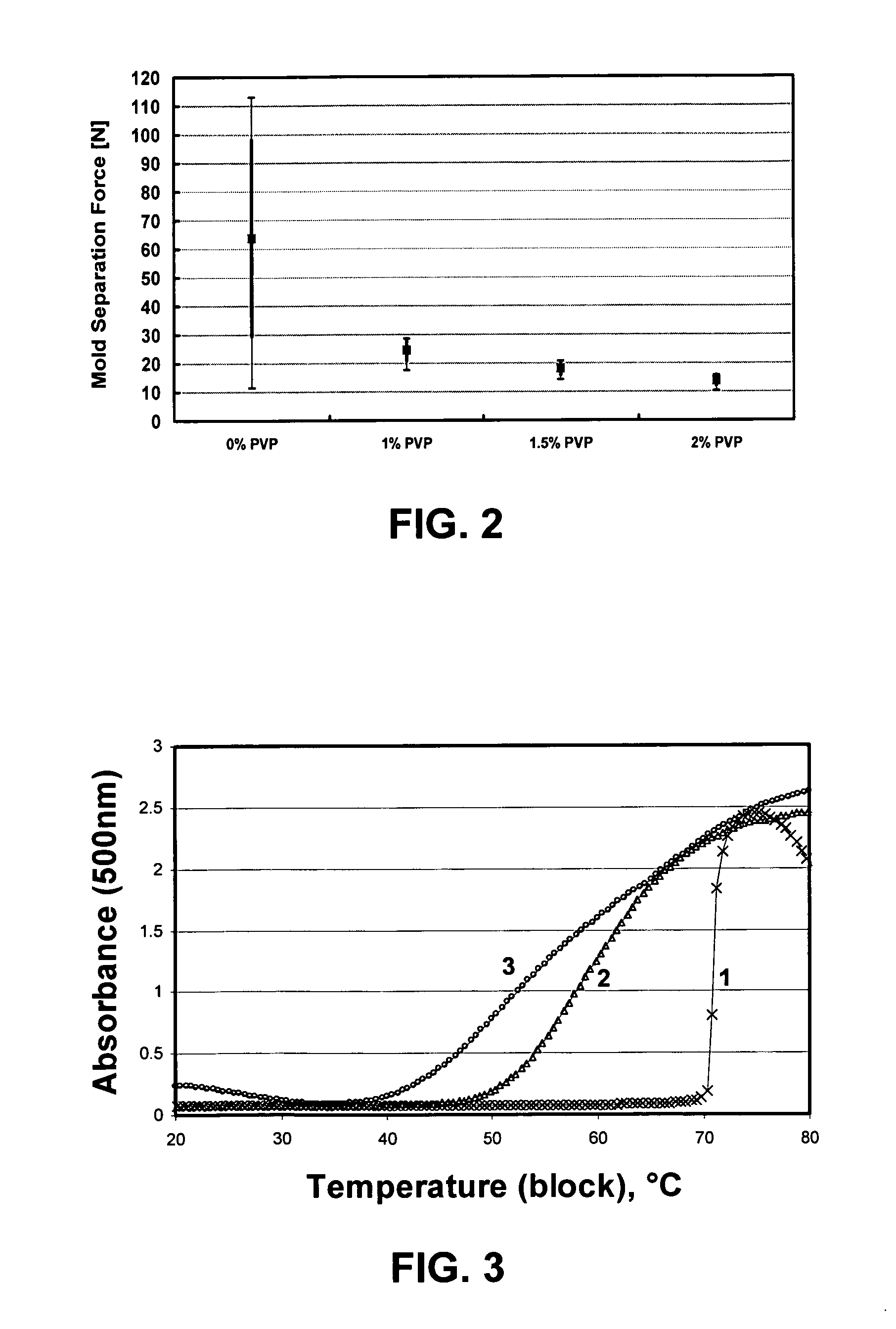Method for making contact lenses
a technology for contact lenses and lenses, applied in the field of contact lens making, can solve the problems of reducing the overall production yield, affecting the quality of contact lenses, so as to achieve high yield, minimize entanglement, and improve quality
- Summary
- Abstract
- Description
- Claims
- Application Information
AI Technical Summary
Benefits of technology
Problems solved by technology
Method used
Image
Examples
example 1
Preparation of Contact Lenses
[0130] Typically 45-65 mg of a polymerizable fluid composition (lens formulation) is charged into the cavity of a female mold half and a male mold half is placed on top of the female mold half to form a mold assembly which is disclosed in detail in U.S. Pat. No. 6,203,909 B1, herein incorporated by reference in its entirety.
[0131] UV light is impinged on the mold arrangement. The light source is a UV-IQ400 manufactured by Dr. Groebel UV Electronic GmbH, fitted with a Phillip HPA-400 / 30S bulb. Light from the source is directed down a light guide and through a WG305 cut-off filter manufactured by Schott Glass. The intensity of light that passes through this optical arrangement is measured with a RM-12 radiometer manufactured by Dr. Groebel Electronic GmbH and calibrated to the manufactures' standard. The irradiation dose is controlled by using a fixed intensity of light and modulating the exposure time through the use of an automated shutter arrangement....
example 2
[0135] This example illustrates the procedure for preparing poly(oxylakylene)-containing polyurea prepolymer.
[0136] Place 400 grams of tetrahydrofuran (THF), 250 grams of water, 84 amine group milli-equivalents (meq) of Jeffamine® XTJ501 (Hunstman Chemicals), 50 amine group meq of Jeffamine® XTJ502 (Hunstman Chemicals) and 26.8 amine group meq of bis-hexamethylenetriamine (Aldrich Chemicals) into a jacketed 1 L reactor and cool to an internal temperature of 0 to 5° C. with agitation. A solution containing 100 isocyante group meq of isophorone diisocyanate (Aldrich Chemicals) and 26.8 isocyante group meq of VESTANAT® T1890 / 100 (Degussa Chemicals) in about 80 grams of THF is added dropwise, with stirring, over a period of approximately 30 minutes. Stir the reaction mixture for a further 30 minutes whilst maintaining an internal temperature of 0 to 5° C. Three additions of 21.5 grams of sodium carbonate (20% aqueous), followed by 3.4 grams of acryloyl chloride (Aldrich Chemicals) are ...
example 3
[0137] Miracare BC-10, polyoxythylene nonylphenol (Mn˜441), Igepal CO-850 (MW˜1100), and PEG (MW˜1000) are tested for their efficacy in reducing mold separation force as mold releasing agents. Miracare BC-10 is a mixture of PEG80 sorbitan Laurate, Cocamidopropyl Betaine, water, Sodium trideceth sulfate, sodium lauroamphoacetate, PEG-150 distearate, sodium laureth-13 carboxylate, Quaterium-15, and tetrasodium EDTA. The composition of the formulations are prepolymer (31.373% by weight), Irgacure 2959 (0.047% by weight), CuP (0.061% by weight) and one of the above listed mold releasing agent (2% by weight). Water is added to make up the remaining percentage. Mold separation force are determined for each formulation. Reduction in MSF (compared to control) is equal to (MSF−MSFcontrol) / MSFcontrol.
TABLE 1Reduction inMSF (N)MSF DtDev (N)High MSF (N)Low MSF (N)MSF (%)Control85.35323147Miracare BC-1046.410653146polyoxythylene916429254—nonylphenolIgepal CO-85066271374123PEG5914803831
[0138] T...
PUM
| Property | Measurement | Unit |
|---|---|---|
| molecular weight | aaaaa | aaaaa |
| molecular weight | aaaaa | aaaaa |
| molecular weights | aaaaa | aaaaa |
Abstract
Description
Claims
Application Information
 Login to View More
Login to View More - R&D
- Intellectual Property
- Life Sciences
- Materials
- Tech Scout
- Unparalleled Data Quality
- Higher Quality Content
- 60% Fewer Hallucinations
Browse by: Latest US Patents, China's latest patents, Technical Efficacy Thesaurus, Application Domain, Technology Topic, Popular Technical Reports.
© 2025 PatSnap. All rights reserved.Legal|Privacy policy|Modern Slavery Act Transparency Statement|Sitemap|About US| Contact US: help@patsnap.com



